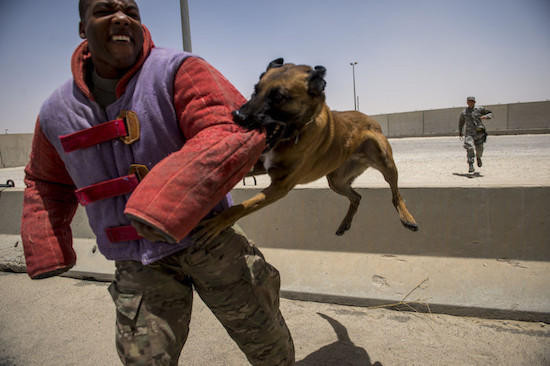Are Military Dogs Trained to Kill? Get real information

Military dogs are trained in a variety of tasks, but not all are trained to kill. These highly skilled canines serve in roles that may include attack training.
In the world of military operations, dogs have carved out a crucial niche, serving alongside soldiers to perform a multitude of tasks. Their rigorous training programs are designed to harness their natural abilities and enhance them to meet military needs.
Whether it’s detecting explosives, tracking, patrolling, or search and rescue, these dogs are prepared to execute the commands of their handlers with precision and loyalty. The intensity of their training depends on their specific role within the military.
While some may be taught controlled aggression, it is important to understand that the primary goal is to protect and serve, not necessarily to kill. Their contribution to national security and soldier safety is invaluable, solidifying their status as unsung heroes within the armed forces.
Military Dogs
Military dogs play crucial roles in defense forces around the world. These trained canines perform tasks ranging from detection to protection, proving their worth beyond companionship. Their training is rigorous, tailored to meet the specific needs of military operations where they save lives and maintain security.
Roles In Modern Warfare
- Detection: Dogs sniff out explosives and drugs.
- Search and Rescue: They locate missing people in disaster zones.
- Patrol: Canines guard bases and sensitive areas.
- Message delivery: They carry messages in conflict areas.
Historical Significance
Military dogs have a long history of service. Their roles evolved from mascots to active field agents. In both World Wars, they delivered messages under fire and detected enemy positions. Their bravery and skills have earned them medals and honors, highlighting their importance in military history.
| Name | War | Role |
|---|---|---|
| Stubby | World War I | Mascot, Sentry |
| Chips | World War II | Guard, Message Carrier |
| Nemo | Vietnam War | Patrol, Attack |
These examples show how vital military dogs are to armed forces. They not only protect teams but also save lives with their unique abilities.

Credit: www.military.com
Breed Selection For Military Service
When selecting the right canine for military service, certain breeds stand out. These dogs must have the right traits and characteristics to perform under pressure. Understanding what makes a breed suitable for such a critical role is key to their success on the field.
Traits And Characteristics
Military dogs need a unique set of skills. They must be intelligent, loyal, and trainable. Agility and strength are also crucial. The ability to remain calm in combat is a must. These canines should possess strong protective instincts without being overly aggressive.
Popular Breeds In The Military
Several breeds have proven themselves as top contenders in military roles. The following are some of the most trusted breeds in service:
- German Shepherds: Known for their intelligence and versatility.
- Belgian Malinois: Valued for their speed and work ethic.
- Labrador Retrievers: Chosen for their detection capabilities and friendly nature.
- Dutch Shepherds: Praised for their obedience and endurance.
Each breed brings its strengths to the military. They undergo rigorous training to serve alongside human counterparts. These dogs are not just pets; they are skilled warriors with a mission.
Training Regimens For Military Canines
The prowess of military dogs is a result of rigorous and specialized training regimens. These canines undergo extensive programs to develop the skills necessary for the demands of military operations. Their training focuses on obedience, tactical skills, and controlled aggression. This ensures they perform their duties effectively while remaining under the handlers’ command.
Basic Obedience
Basic obedience is the foundation of military canine training. Here, dogs learn to respond to basic commands, ensuring they follow their handler’s lead without hesitation. This training includes:
- Sit, stay, and come: Fundamental commands for control and coordination.
- Heel: The dog learns to walk alongside the handler without pulling.
- Leash training: Ensures the canine can be guided without issue.
Advanced Tactical Training
After mastering basic commands, military dogs move on to advanced tactical training. This prepares them for complex operations.
- Parachute jumps: Training for airborne operations alongside soldiers.
- Night operations: Operating in low-light conditions with stealth.
- Detection: Identifying explosives or hazardous materials.
Military canines also learn to navigate obstacles, track targets, and patrol areas with vigilance. Controlled aggression is taught to neutralize threats, not to kill. Safety is paramount, ensuring these dogs act on command.
The Reality Behind ‘killer’ Dogs
The term ‘killer dogs’ often misleads people about military dogs. These trained canines do much more than people think.
Aggression Vs. Control
Military dogs must balance aggression with control. They learn to be aggressive only on command. Trainers use positive reinforcement to teach these skills.
- Attack training is precise and controlled.
- Dogs learn to stop attacking through a release command.
Rules Of Engagement
Rules strictly guide the use of military dogs in operations. These rules ensure that the use of dogs is ethical and necessary.
- Dogs must not engage unless commanded.
- Handlers assess the threat before releasing dogs.
Non-combat Roles Of Military Dogs
Military dogs serve in various roles beyond the battlefield. These canine heroes take on tasks that save lives and provide emotional support. Their training prepares them for a range of missions that do not involve direct combat.
Search And Rescue Operations
Military dogs excel in search and rescue operations. Their keen sense of smell allows them to locate missing persons in disaster zones. Teams often deploy these dogs after earthquakes, floods, or avalanches. They can navigate through debris and alert rescuers to survivors trapped under rubble.
- Trained to work in challenging environments
- Can quickly find people in large search areas
- Essential in natural disaster response efforts
Therapeutic And Support Duties
Military dogs also fulfill critical therapeutic and support duties. They work as therapy dogs, helping soldiers cope with stress and trauma. These dogs provide comfort and companionship, which is vital for mental health. They often visit hospitals and rehabilitation centers to aid in recovery.
- Assist in reducing stress and anxiety
- Promote healing and emotional well-being
- Support soldiers and veterans with PTSD

Credit: en.wikipedia.org
Mythbusting: Military Dogs In Civilian Life
Many believe military dogs are too aggressive for a family environment.
Rehabilitation And Adoption
Retired military dogs often seek loving homes. These heroes undergo careful rehabilitation. Trainers ensure they adapt well to civilian life.
- Assessment: Each dog receives a thorough evaluation.
- Behavioral Adjustment: Experts address any issues.
- Matching: Dogs are paired with suitable families.
Successful adoptions are common. Many families enjoy life with their new, disciplined pets.
Temperament Misconceptions
Some think military dogs are always on edge. This is a myth. Military training includes obedience and control.
Military dogs are:
| Loyal | Disciplined | Affectionate |
|---|---|---|
| They form strong bonds. | They follow commands. | They show love to their handlers. |
With proper introduction and care, these dogs can be gentle companions.
The Bond Between Soldiers And Their Dogs
Military dogs do more than missions. They build unbreakable bonds with their handlers. These bonds go beyond the battlefield. They become each other’s trusted companion. Let’s explore how trust and loyalty, along with impact on soldier morale, define these extraordinary relationships.
Trust And Loyalty
The relationship between a soldier and their dog is built on mutual trust. Soldiers trust their dogs with their lives. Dogs protect their partners no matter what. This bond is life-saving in dangerous situations.
- Dogs detect threats that humans can’t.
- They work tirelessly to keep soldiers safe.
- Handlers care deeply for their canine companions.
Both soldier and dog train together, eat together, and rest together. This strengthens their loyalty. They become a single unit of trust.
Impact On Soldier Morale
Military dogs have a positive effect on soldier morale. Their presence helps soldiers feel less stressed. Dogs bring comfort after hard missions. They provide a sense of home and normalcy.
- Soldiers with dogs report feeling happier.
- Dogs offer unconditional love and support.
- A dog’s companionship can ease the strain of war.
In camps, dogs can be seen lifting spirits. They play and provide much-needed breaks from the stress of duty. These dogs become morale boosters for the whole unit.
Together, a soldier and their dog create a powerful team. Their bond is one of trust, loyalty, and shared experiences. It shows that even in the toughest times, the love between a soldier and their dog remains unshaken and true.
Legal And Ethical Considerations
Discussing the role of military dogs raises crucial legal and ethical issues. These noble animals serve alongside human soldiers, but their welfare remains a key concern. Let’s explore the implications of animal rights and international laws on their training and use in combat.
Animal Rights In Military Context
Military dogs have rights, just like any other animal. Their training and missions must respect these rights. Here, we delve into how these rights apply to military contexts.
- Basic Welfare: Military dogs deserve proper care, including food, shelter, and medical attention.
- Humane Training: Training methods should not be cruel or cause unnecessary suffering.
- Retirement: After service, these dogs should enjoy a peaceful retirement.
International Laws And Protocols
International laws guide the use of animals in military operations. Countries must follow these rules to protect dogs in service.
| Law/Protocol | Focus |
|---|---|
| Geneva Conventions | Protection of war animals |
| Hague Conventions | Rules of war conduct |
| Customary IHL | Welfare during conflict |
These documents outline how countries should treat military dogs. They ensure animals are not overworked or used in ways that cause needless harm.
Future Of Military Dogs
The role of military dogs has been crucial in various operations across the globe. As we look to the future, these canine companions are set to become even more integral to military efforts. With advancements in technology and evolving roles, military dogs will continue to serve alongside soldiers, showcasing their adaptability and importance.
Technological Advancements
The integration of technology in military canine units is a game-changer. Cutting-edge gear, such as smart harnesses and communication devices, allows dogs to perform complex tasks with greater precision. Innovations like augmented reality goggles enable handlers to give commands from a distance, ensuring safety and efficiency in critical missions.
- Smart harnesses monitor health stats
- Communication devices allow remote commands
- Augmented reality for enhanced field vision
Evolving Roles And Responsibilities
Military dogs are taking on new roles beyond traditional search and patrol duties. These roles include cybersecurity, where dogs detect electronic devices, and support roles to comfort soldiers. Their responsibilities are expanding, demonstrating versatility and an enduring bond with their human counterparts.
| Traditional Role | New Role |
|---|---|
| Search and Rescue | Cybersecurity |
| Patrol | Therapeutic Support |
Credit: www.businessinsider.com
Conclusion
Military dogs are highly skilled partners, not mere weapons. Their training focuses on control and obedience, not aggression. These canines serve valiantly, saving lives and providing support rather than being primed for attack. Understanding their role honors their service and dispels misconceptions about their duties.







